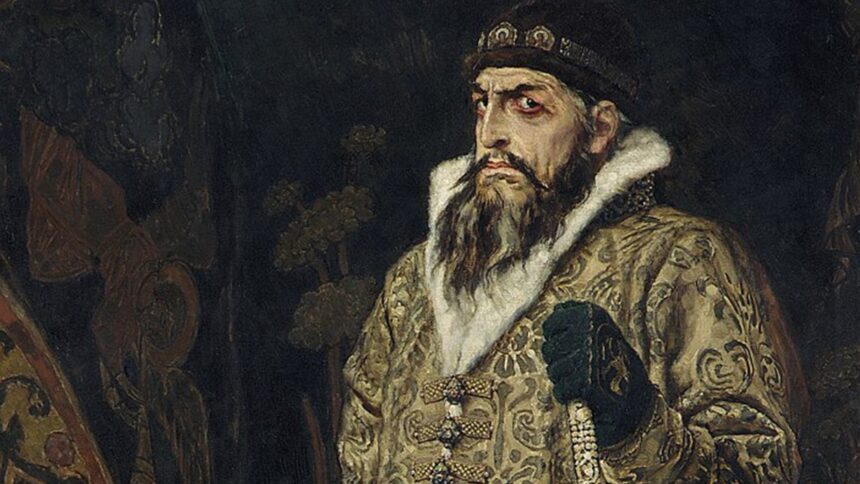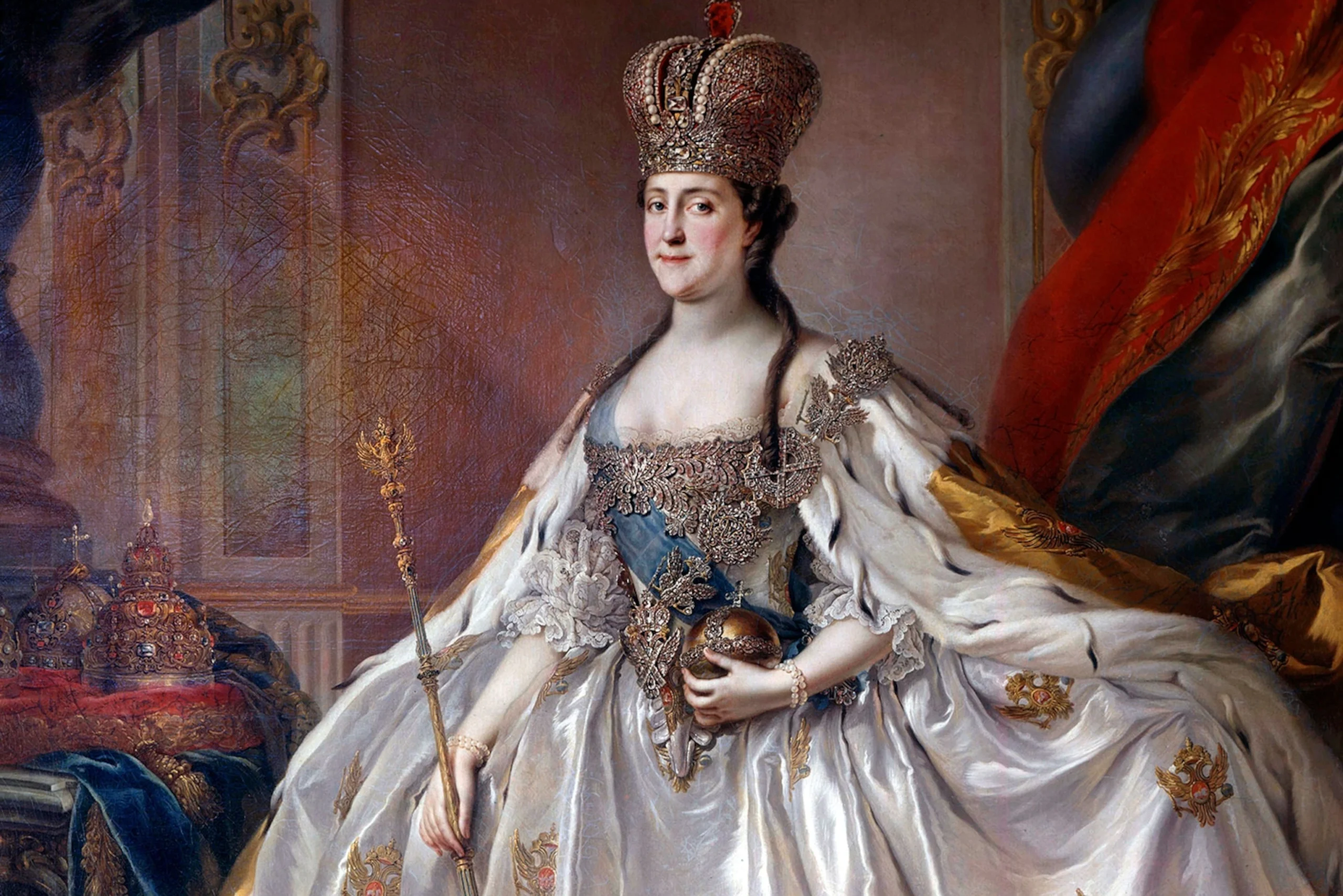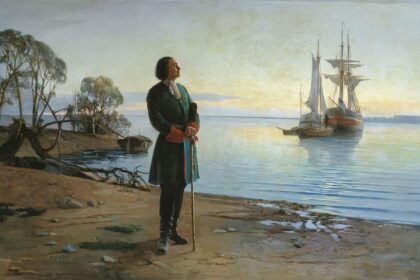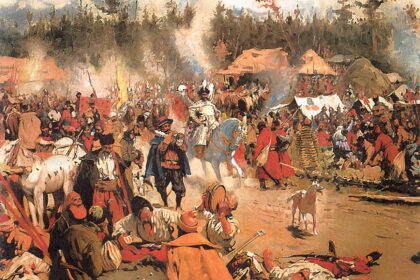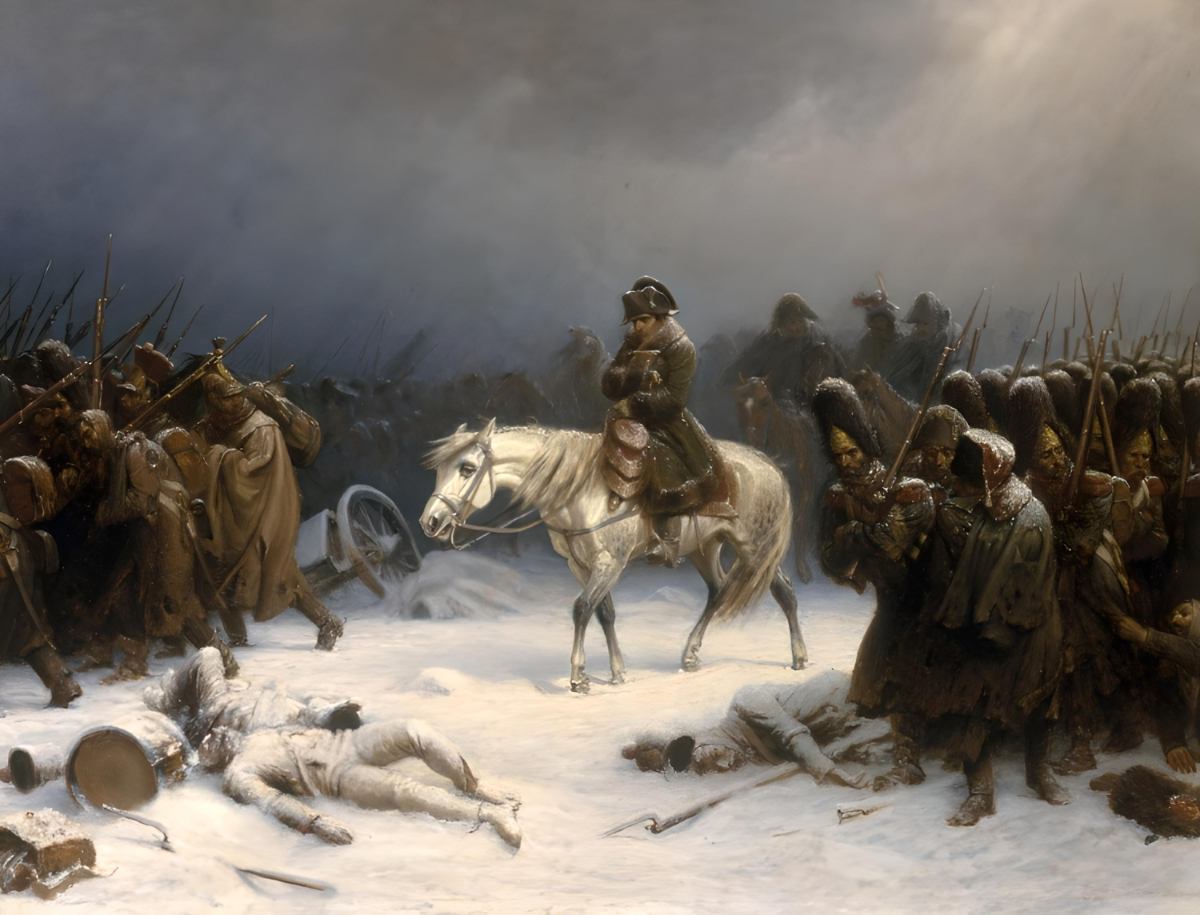Ivan the Terrible (1530–1584) is, for most of our contemporaries, a symbol of Russian history in the 16th century—a period when the separate lands and principalities of Northeast Rus were being united into a single Muscovite state, raising questions about how, by what means, and in what form this process would take place. The first crowned Russian tsar did much—both in words and deeds—to establish what he considered the only correct order.
- In His Childhood, Ivan the Terrible Tortured Animals
- Ivan the Terrible Suffered From Seizures
- Ivan the Terrible Went Mad After the Death of His First Wife
- He Constantly Took New Wives and Got Rid of the Old Ones
- Ivan the Terrible Was Actually Homosexual
- He Earned His Nickname “Terrible” for His Cruelty
- Red Square Is Called So Because Ivan the Terrible Executed People There
- Ivan the Terrible Was Very Religious and Constantly Repented
- Ivan the Terrible Was a Strong Ruler and Raised Russia From Its Knees
- Ivan the Terrible Hated the Boyars
- Ivan the Terrible staged his abdication because he was tired of ruling
- Ivan the Terrible Killed His Son
- Ivan the Terrible Conquered Siberia
- He Was Well-Educated, Knew Many Languages, and Had His Own Library
- Ivan the Terrible Did Not Die a Natural Death: He Was Poisoned
He ruled for a very long time, and during this period, many important and tragic events occurred. Given that his era was remembered for a long time while authentic evidence about it has remained scarce, it is not surprising that various legends emerged. However, he had many opponents, and the prolonged struggle with neighboring Poland-Lithuania and Sweden led to a real information war.
In His Childhood, Ivan the Terrible Tortured Animals
The wild youth of the future Tsar, who allegedly threw animals off roofs and trampled passersby on horseback, was described in the History of the Grand Prince of Moscow by Prince Andrey Kurbsky—a former boyar, military leader, and later a political emigrant. On the one hand, children, even royal ones, can be cruel in their games. On the other hand, Kurbsky’s History aimed to expose the tyrant Tsar, and what better way to do so than with such a vivid illustration?
Verdict: Unproven
Ivan the Terrible Suffered From Seizures
What are seizures? Migraines are one thing, uncontrollable anger is another, and epilepsy is yet another. The Tsar was a superstitious man who frequently sought treatment, but attempting to diagnose him based on stories—especially those from people who never had access to his chambers—450 years later is a difficult and speculative endeavor. A study of his remains conducted in the 1960s revealed that the sovereign suffered from a range of musculoskeletal diseases. However, it is impossible to determine his mental state from his skeletal remains.
Verdict: Unknown
Ivan the Terrible Went Mad After the Death of His First Wife
Regarding the mental disorder aspect, as mentioned previously, the tsar seemed to have genuinely loved his first wife, Anastasia, whom he referred to as a “young maiden” in his second letter to Kurbsky. He continued to remember and speak of her fondly many years later, suggesting a deep and lasting affection. He either believed—or convinced himself—that she had been poisoned by his enemies.
While it is unlikely that he trusted absolutely no one (otherwise, how could he have managed the state?), it is true that his suspicions eventually led him to exile or execute those he once trusted. This was the case with his early advisors, like Alexei Adashev and the priest Sylvester, as well as the leaders of his oprichnina—Athanasius Vyazemsky, Mikhail Cherkassky, and Alexei Basmanov.
Verdict: False
He Constantly Took New Wives and Got Rid of the Old Ones
The tsar’s personal life was as convoluted as his politics. After the deaths of his first wife, Anastasia Romanovna, and his second, the Kabardian princess Maria Temryukovna, he married Marfa Sobakina, who died just 15 days after their wedding for unknown reasons. In 1572, the tsar forced the clergy to permit him a fourth marriage—despite the Church generally not approving even a third marriage, which it considered “swine-like living.” He then married a fifth time, but both Anna Koltovskaya and Anna Vasilchikova were subsequently sent to monasteries.
Vasilisa Melentyeva, it seems, was never a legal wife. The last tsarina, Maria Nagaya, married the tsar in 1580 and gave birth to Tsarevich Dmitry, who died in 1591 in Uglich under circumstances that remain unclear. However, shortly before his death, Ivan the Terrible was still making new matrimonial plans; he sent a special envoy, Fyodor Pisemsky, to England to seek the hand of Queen Elizabeth’s relative, Mary Hastings.
Verdict: He loved marrying, but the accusation is unfounded
Ivan the Terrible Was Actually Homosexual
According to foreign writers, Ivan Vasilyevich “began to incline” towards the “Sodomite sin” with his favorite, Fyodor Basmanov. However, no one held a candle to prove it. The tsar certainly did not become an “ideological” homosexual: in his military campaigns, he was usually accompanied by concubines, and near the end of his life, he boasted to the English ambassador Jerome Horsey that he had defiled a thousand girls. It seems Ivan the Terrible believed that no moral restrictions existed for his “absolute royal autocracy,” thus demonstrating his superiority to the court entourage.
Verdict: This cannot be verified
He Earned His Nickname “Terrible” for His Cruelty
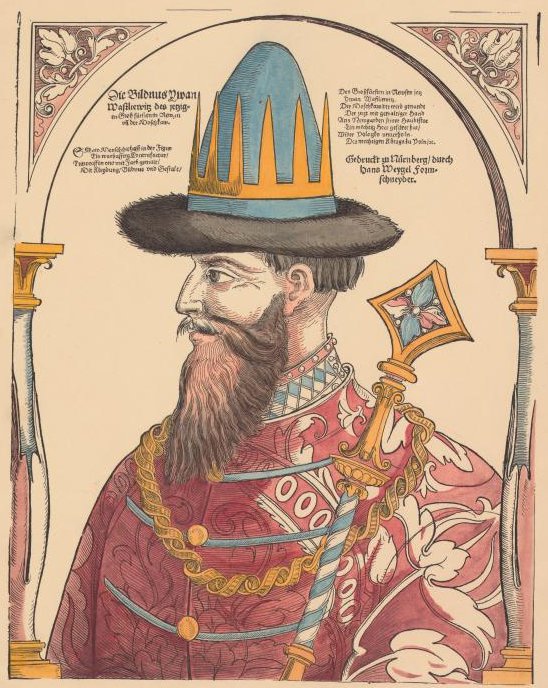
The tsar executed people by impalement and other methods more than once. However, it is worth remembering that those were different times, and human life was valued differently than in our politically correct era. Moreover, the term “terrible” has a different connotation than “cruel” or “bloody” — it means “severe,” “dangerous to enemies,” or “strict.”
In those grim medieval times, executions were common both in the West and the East. Ivan’s atrocities stood out because they were deliberately theatrical. According to a contemporary, Ivan the Terrible summoned Boyar Ivan Fedorov to the palace, made him take his throne, and said, “You have what you sought, what you aspired to, to become the Grand Prince of Moscow and take my place,” after which he personally stabbed the old servant.
In the summer of 1570, at Chistye Prudy in Moscow, he first spectacularly pardoned more than a hundred “traitors” who had already said goodbye to life — releasing them to their wives and children — and then arranged a showy execution for the remaining 120, including many prominent clerks of Moscow’s administrative orders. And not just executions but with creativity. The “Piskarev Chronicle” reports that the tsar “ordered the execution of clerk Ivan Viskovatov by cutting him limb by limb and another clerk, Nikita Funikov, by boiling him in water.”
Along with them were executed Vasily Stepanov, who headed the Land Office, Ivan Bulgakov, head of the Grand Revenue, the main financial department of Russia at that time, and Grigory Shapkin, head of the Robbery Order (similar to the Ministry of Internal Affairs). Numerous executions were not seen as excessive cruelty — how could one not rejoice at the punishment of corrupt officials and traitors? Here was a sovereign who knew both how to execute and pardon!
The life of the oprichnina guard in Aleksandrovskaya Sloboda was filled with a grim solemnity. After punitive expeditions, the tsar and his servants would don monastic robes. Ivan IV himself, acting as “abbot” with Malyuta Skuratov, would ring the bells in the morning, gathering the “brotherhood” for prayer; those who failed to appear were punished. During the long service, the tsar and his sons would pray and sing in the church choir, then proceed to the refectory, after which they would return to regular state affairs.
Verdict: He earned the nickname, but not for cruelty
Red Square Is Called So Because Ivan the Terrible Executed People There
The word “red” in the name “Red Square” means “beautiful,” just like in the phrase “red maiden.” It only began to be called this from the end of the 17th century.
Verdict: False
Ivan the Terrible Was Very Religious and Constantly Repented
From his royal height, Ivan the Terrible disdainfully called the Swedish King John III a “sufferer,” and even in his message to his adversary, King Stephen Báthory of the Polish-Lithuanian Commonwealth, he found it necessary to state that he was the “Tsar of great states by God’s will, not by the rebellious human desire.” But from his immeasurable pride, he would suddenly turn to repentance: “… the body is weary, the spirit is in pain, the sores of the body and soul multiply… <…> … I fell into the robbers, both mental and sensory… For this reason, I am hated by all,” he described his mental state in his will in the summer of 1572 in Novgorod, where the Tsar awaited news of the decisive battle with the Crimean Khan Devlet Giray.
After the death of his heir, Tsarevich Ivan, the shocked Tsar ordered lists of those executed on his orders to be compiled and sent to monasteries along with large sums of money for monastic prayers for the deceased. According to these lists (“Synodiks of the disgraced”), about 4,000 people were killed.
Verdict: True
Ivan the Terrible Was a Strong Ruler and Raised Russia From Its Knees
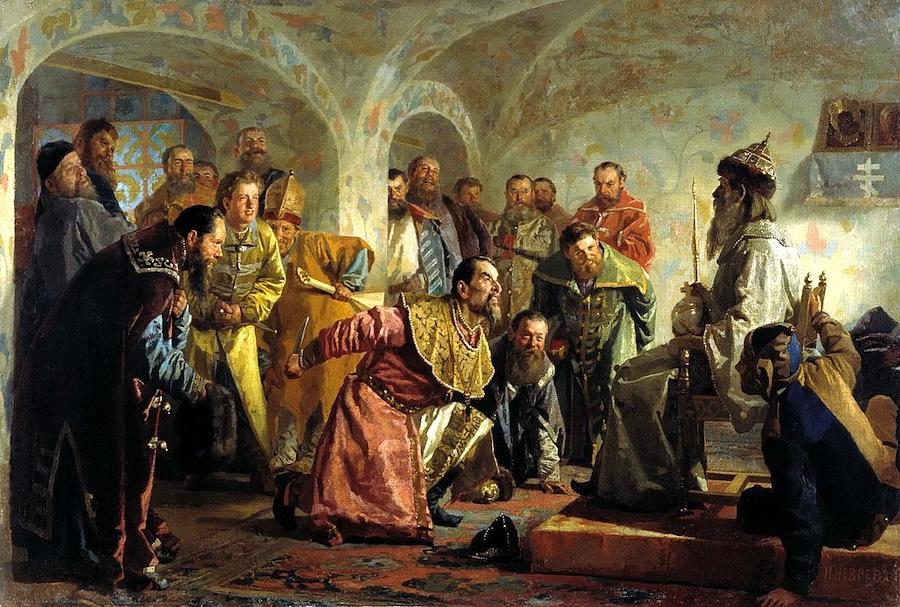
Russia in the early 16th century was not “on its knees” but was a young, rapidly growing power. Different people have different interpretations of the phrase “strong ruler.” For some, it means cutting off the heads of enemies; for others, it means creating conditions for the country’s successful development. It was precisely during Ivan’s reign in the 1570s that a crisis began in the country. The devastation of the lands due to the hardships of the Livonian War and the introduction of the oprichnina led to frequent departures of peasants from private lands.
The cadastral books of the early 1580s indicate that in many districts, arable land was significantly reduced, and the population either died out or fled, as evidenced by such entries: “The oprichniks tortured, plundered livestock, burned down the yard.” Zemstvo districts paid two or even three times more taxes in the 1570s than householders. Cities suffered not only from repression but also from the “resettlements” of merchants to Moscow—thus, the layer of wealthy and enterprising people in provincial towns was eliminated.
The executions of voivodes and the “desolation” of noble estates undermined the army’s combat capability: nobles in the late 1570s were beaten with whips to force them to go to war.
Verdict: False
Ivan the Terrible Hated the Boyars
A boyar in the 16th century was not a special breed of harmful people but the highest rank among the then elite, the Tsar’s court. Members of the Boyar Duma, the Tsar’s voivodes, ambassadors, governors—all came from several dozen noble families whose ancestors had served the Moscow princes for generations. It was impossible to do without them. The descendant of the legitimate rulers, Tsar Ivan Vasilyevich, could execute a particular boyar, but it never occurred to him to appoint the most loyal but common men or even obscure provincial nobles in their place.
Therefore, in the oprichnina, the Tsar’s new servants were not of low birth. The oprichnaya Duma was headed by Kabardian Prince Mikhail Cherkassky, brother of the new Tsarina Maria; there were representatives of ancient families—boyars Alexei Basmanov and Fyodor Umnov-Kolychev; princes Nikita Odoevsky, Vasily Tyomkin-Rostovsky, Ivan Shuisky. Among other oprichniks were the Rurikids and Gediminids—Princes Rostovsky, Pronsky, Khvorostinin, Volkonsky, Trubetskoy, Khovansky.
There were also members of other old and honest Moscow families—Godunovs, Saltykovs, Pushkins, Buturlins, Turgenevs, Nashchokins. Even the chief executioner of the oprichnina, Malyuta Skuratov-Belsky, came from a quite respectable serving family.
Verdict: False
Ivan the Terrible staged his abdication because he was tired of ruling
On October 30, 1575, Ivan the Terrible placed the baptized Tatar Tsarevich Simeon Bekbulatovich on the throne. In his petition to Simeon Bekbulatovich, he modestly called himself “little Prince Ivanchik of Moscow” and settled “beyond Neglinnaya… on Arbat opposite the Old Stone Bridge.” However, he did not give up real power to anyone, and after 11 months, he returned to his previous place, appointing Simeon as the Grand Duke of Tver.
Historians still debate what this spectacle meant. Did the Tsar want to quietly revive the oprichnina? Use others to take away the privileges of the Church? Was he claiming the throne of the neighboring Polish-Lithuanian state?
Verdict: Unknown
Ivan the Terrible Killed His Son

Most historians mention conflicts between father and son, whether due to the Tsar’s dissatisfaction with his daughter-in-law (he believed she dressed inappropriately) or because of suspicions and jealousy of his son, whom the people wanted to see at the head of the army. We will never know for sure what happened on that November night in 1581, but it can be said that Ilya Repin’s famous painting does not correspond to reality.
Documents preserved and published in the late 19th century indicate that the Tsarevich “fell ill”; his father summoned doctors from Moscow to his quarters, but the treatment was unsuccessful, and after 11 days, Ivan Ivanovich died. What caused the illness, and whether there was indeed a fatal blow to the head with a staff, we will never know: when the Tsarevich’s grave was opened, it was found that his remains had turned to dust, with only the lower jaw of the skull remaining.
Verdict: Unknown
Ivan the Terrible Conquered Siberia
Firstly, the “conquest,” or rather the annexation, of Siberia was a long process that was only completed in the 18th century; its exploration and exploitation continue to this day. Secondly, there is no reason to believe that Tsar Ivan was the initiator or leader of this enterprise.
The salt producers, the Stroganovs, invited the daring ataman Yermak Timofeyevich and his detachment to protect their possessions in the Cis-Ural region from raids by the Siberian Khan Kuchum. In the autumn of 1582, Yermak’s detachment of 540 men moved beyond the Urals. A small group of people crossed the mountains and, via the Tobol and Irtysh rivers, penetrated the heart of the Siberian Khanate and captured its capital, Qashliq, from where Yermak sent messengers to Moscow with gifts and news of the victory.
In 1585, Yermak himself died, but new detachments of Cossacks and Moscow serving men followed in his footsteps. The development of Siberia began, with new towns appearing: Tyumen, Berezov, Tara; Tobolsk was built on the Irtysh as the Siberian capital; and the fortress of Verkhoturye became the gateway to Siberia through which the only overland route passed.
Verdict: False
He Was Well-Educated, Knew Many Languages, and Had His Own Library
Tsar Ivan undoubtedly possessed a literary gift that was, as they say, given by God. He had a rare talent for figurative thinking and a “biting” style, which was unusual for a medieval scholar. The Tsar was always capable of making a joke, a sharp remark, or an unexpected turn of phrase. For example, Prince Kurbsky solemnly declared to Ivan: “… I believe you shall not see my face until the Day of Judgment.” To which the Tsar mockingly replied: “Who indeed wishes to see such an Ethiopian face?”
The Tsar’s literary interests were not limited to his series of letters and correspondence with Boyar Kurbsky. One of the mysteries of the 16th century is the whereabouts and composition of the Tsar’s library. The chronicle of Riga’s burgomaster Nienstedt contains a story about how the Tsar’s close associates took several books in Greek, Latin, and Ancient Hebrew from a walled-up room and showed them to the Livonian pastor Johann Wetterman.
In 1819, Christoph Dabelow, a professor at the University of Dorpat, discovered an inventory of the library’s books that included works by Cicero, Tacitus, Polybius, Aristophanes, and other ancient authors. Unfortunately, neither the originals of this inventory nor the library itself have been found to this day, despite numerous attempts to search for them. However, even without these manuscripts, more than 100 books that once belonged to the Tsar are known to exist.
At the initiative of Ivan IV, the Illustrated Chronicle Codex was compiled—a monumental history of humanity from the creation of the world, including his own reign. Mysterious “additions” by an unknown editor on the margins of the last volumes of this codex contain unique information about events at the court of Ivan the Terrible. Even if these notes were not written by the Tsar himself (in the 16th century, writing was not considered a “royal” occupation), his role as a powerful and biased editor of the history of his reign is unquestionable.
The Tsar could suddenly start a theological dispute during a reception or, in frustration over a failed political alliance, write to the English Queen Elizabeth I in 1570 in response to her diplomatic explanation that such treaties require discussion in Parliament: “But it appears that other people, not you, rule over you, and not only people but merchants… And you remain in your maidenly status like a common girl.”
At the end of his life, under the pseudonym Parfeny the Fool, he wrote a canon to the “terrible warrior”—the Archangel Michael. His words express both fear of the appearance of the fearsome angel and hope for the salvation of his sinful soul: “Reveal to me my end, so that I may repent of my evil deeds, so that I may cast off the burden of sin from myself. The journey with you is long. Fearsome and terrible angel, do not frighten me, a feeble man. Grant me, O angel, your humble coming and beautiful walk, and I will greatly rejoice in you. Fill me, O angel, with the cup of salvation.”
Verdict: True
Ivan the Terrible Did Not Die a Natural Death: He Was Poisoned

Dying in the 16th century, even for a Tsar, was not difficult given the state of medicine at that time, and Ivan Vasilyevich’s health had significantly declined by the end of his life. On March 18, 1584, the Tsar passed away; rumors of his violent death spread through Moscow, but it is impossible to prove or disprove them. Historians do not have a unanimous opinion on this matter. An examination of the Tsar’s skeletal remains revealed a high mercury content, but this could have been caused by the common medical ointments of the time, which Ivan used to treat syphilis.
Verdict: Unknown


